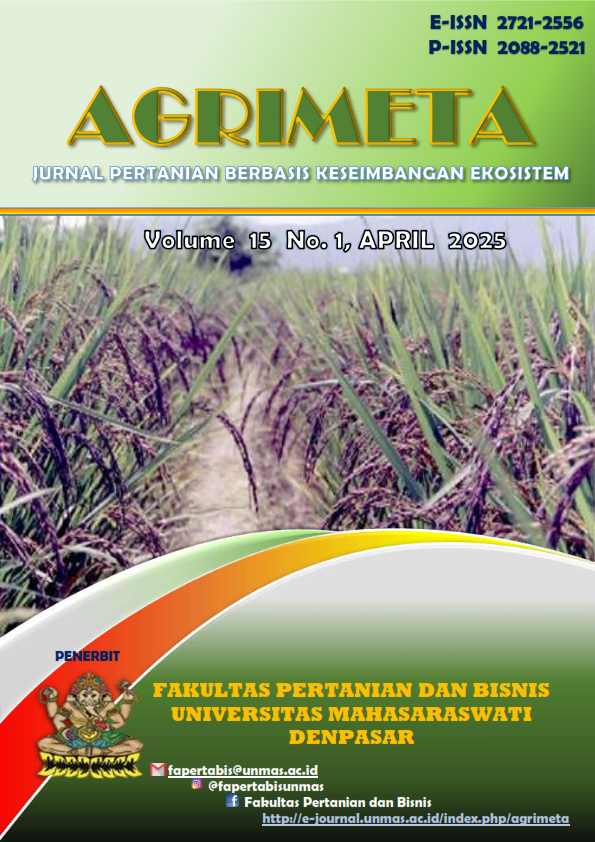OPTIMIZATION OF THE MARKETING CHAIN OF TRADITIONAL PRODUCTS: A CASE STUDY OF SUPUTRA HERBAL INCENSE IN ABIANSEMAL DISTRICT
DOI:
https://doi.org/10.36733/agrimeta.v15i1.12600Keywords:
Marketing Channel, Marketing Margin, Herbal Incense, MSMEAbstract
Dupa Herbal Suputra, a micro, small, and medium enterprise (MSME) located in Angantaka Village, Abiansemal District, Badung Regency, has great potential in developing natural and spiritually significant herbal incense products. This study aims to analyze the marketing channels and calculate the marketing margins of the herbal incense products. The research used a combination of qualitative and quantitative methods. The study was conducted at Dupa Herbal Suputra MSME in Angantaka Village, Abiansemal District, Badung Regency, over a period of two months, from November to December. Data collection instruments included interviews and recordkeeping. The results showed that there are three marketing channel patterns: (1) a one-level channel (producer–consumer), (2) a two-level channel (producer–retailer–consumer), and (3) a three-level channel (producer–collector–retailer–consumer). The marketing margin for Dupa Herbal Suputra was zero in the first channel due to direct transactions. The second channel yielded a margin of IDR 3,000, while the third channel provided a margin of IDR 5,000. This study recommends enhancing direct marketing through digital platforms to improve efficiency and producer margins. In addition, training in business management and market access is important to improve the competitiveness of local MSMEs.
Downloads
References
Acharya, S. S., & Agarwal, N. L. (2010). Agricultural Marketing in India. Oxford and IBH Publishing.
Bairagi, S. K., Roy, D., & Nasrin, M. (2018). Marketing Efficiency and Value Chain Analysis of Agricultural Commodities in Bangladesh. Journal of Agribusiness in Developing and Emerging Economies, 8(4), 766–782.
Barbieri, C., & Mshenga, P. M. (2008). The Role of the Firm and Owner Characteristics on the Performance of Agritourism Farms. Sociologia Ruralis, 48(2), 166–183.
Chatterjee, S., Rana, N. P., Dwivedi, Y. K., & Baabdullah, A. M. (2021). Understanding AI Adoption in Retail Using TAM and TOE Frameworks. International Journal of Information Management, 57, 102304.
Coughlan, A. T., Anderson, E., Stern, L. W., & El-Ansary, A. I. (2006). Marketing Channels (7th ed.). Pearson Education.
Daengs, S., & Aripin, R. (2018). Manajemen Pemasaran dan Pengaruh Teknologi dalam Bisnis Modern. Jurnal Ilmu Ekonomi dan Bisnis, 4(2), 112–125.
Daryanto, A., & Nurmalina, R. (2015). Manajemen Rantai Pasok Agribisnis. IPB Press.
Fernandez-Stark, K., Bamber, P., & Gereffi, G. (2011). The Fruit and Vegetable Global Value Chain. Center on Globalization, Governance & Competitiveness, Duke University.
Gadde, L.-E., & Håkansson, H. (2001). Supply Network Strategies. Wiley.
Gereffi, G., & Fernandez-Stark, K. (2016). Global Value Chain Analysis: A Primer (2nd ed.). Center on Globalization, Governance & Competitiveness, Duke University.
Gunasekaran, A., Subramanian, N., & Papadopoulos, T. (2017). Information Technology for Competitive Advantage Within Logistics and Supply Chains: A Review. Transportation Research Part E: Logistics and Transportation Review, 99, 14–33.
Hartono, A. (2020). Analisis Margin dan Efisiensi Saluran Pemasaran Produk Hortikultura. Jurnal Agribisnis Indonesia, 8(1), 45–53.
Khaswarina, L., Rahayu, D., & Saputra, A. (2018). Efisiensi Pemasaran Produk Pertanian di Era Modernisasi. Jurnal Sosial Ekonomi Pertanian, 7(3), 133–140.
Kohls, R. L., & Uhl, J. N. (2002). Marketing of Agricultural Products (9th ed.). Prentice Hall.
Kotler, P., & Keller, K. L. (2016). Marketing Management (15th ed.). Pearson Education.
Kurniawati, D., Saptana, & Suryani, E. (2022). Farmer's Share Analysis in Horticulture Supply Chain. Jurnal Agro Ekonomi, 40(1), 33–44.
Melovic, B., Dudic, B., Vatin, N., & Jovovic, A. (2022). Marketing Strategy for Products of Organic Origin: Evidence from a Developing Market. Foods, 11(2), 321.
Reardon, T., Barrett, C. B., Berdegué, J. A., & Swinnen, J. F. M. (2012). Agrifood Industry Transformation and Small Farmers in Developing Countries. World Development, 37(11), 1717–1727.
Septiani, N. K. A. (2021). Wawancara Pemilik Usaha Dupa Herbal Suputra. Dokumentasi Lapangan, Abiansemal, Badung.
Septiani, R. (2021). Potensi Pemasaran Dupa Herbal di Bali. Jurnal Agrimandiri, 6(2), 80–89.
Sugiyono. (2018). Metode Penelitian Kuantitatif, Kualitatif, dan R&D. Alfabeta.
Tiwari, R., Shaikh, A. A., & Sanyal, S. (2021). Digital Transformation of Marketing in MSMEs: Opportunities and Challenges. Small Enterprise Research, 28(2), 103–122.
Trienekens, J. H. (2011). Agricultural Value Chains in Developing Countries. International Food and Agribusiness Management Review, 14(2), 51–82.
Xu, H., Lu, Y., Li, Z., & Liu, X. (2020). Digital Technologies and Supply Chain Performance: Evidence from Chinese Manufacturing Firms. International Journal of Production Economics, 228, 107693.
Yuliardi, R. (2021). Struktur Saluran Distribusi Produk UMKM dan Dampaknya Terhadap Margin Pemasaran. Jurnal Ekonomi dan Bisnis Terapan, 7(1), 55–64.
Downloads
Published
How to Cite
Issue
Section
License
Copyright (c) 2025 Frumensius Dakosta Joro, Nyoman Yudiarini, Luh Putu Kirana Pratiwi

This work is licensed under a Creative Commons Attribution-NonCommercial-ShareAlike 4.0 International License.






